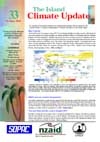An overview of the present climate in the tropical South Pacific Islands, with an outlook for the coming months, to assist in dissemination of climate information in the Pacific region.
Number 33 – 10 June 2003
May’s climate: The South Pacific Convergence Zone (SPCZ) was displaced further east than average, with enhanced convection and above average rainfall over Samoa and the Northern Cook Islands, and the Tuamotu Islands of French Polynesia. Rainfall totals were also above average in parts of Vanuatu and New Caledonia. A region of suppressed convection and below average rainfall persisted along the equator from Nauru east across Kiribati, and to the north of the Marquesas Islands. Air temperatures were above average throughout much of the tropical Southwest Pacific. Although the tropical cyclone season has officially ended, two tropical cyclones ‘EPI’ and ‘GINA’ formed in the western south Pacific at the beginning of June.
ENSO and sea surface temperatures (SST): Sea surface temperature conditions in the equatorial Pacific indicate a rapid shift towards a La Niña like pattern. However, the Southern Oscillation Index (SOI) has been fluctuating, the May mean being -0.8. Most of the global climate models indicate a short period of moderate La Niña conditions, followed by a return to neutral conditions during the later part of 2003. Next month’s ICU will provide a detailed summary on winter outlook in regards to La Niña.
Forecast validation: How well are we doing with our predictions?
Three month outlook: Rainfall is expected to be average or above average from Papua New Guinea to the Solomon Islands, and also from Wallis and Futuna across to the Northern Cook Islands and Society Island (including Samoa and Tokelau). Average or below average rainfall is forecast for the Marquesas Islands. Near average rainfall is most likely elsewhere.
Feature article: Update on Pacific Island Rainfall Outlooks.
Sources of South Pacific rainfall data.

A complete copy of The Island Climate Update is available as an Adobe Acrobat PDF file. This does not contain any extra information over that obtained by clicking on the individual items above.
To view the PDF file, you'll need Adobe Acrobat Reader, which you can download free from Adobe.
